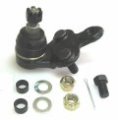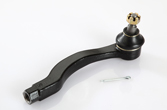|
Ball Joints, in some place also called guide joint, is designed to make the connection and hence provide the support between the front axle wish bone and the axle body (steering knuckle). The installation point of car ball joint is always at the triangular tip of the wishbone. Ball Joint is therefore located opposite the rotation axis of the wishbone. Ball Joints installed upright or suspended transfer the longitudinal and lateral forces into this link. The mounting height is adjusted and fixed via the ball stud pin. It can be designed as a cone, with frontal threaded stud and nut, or as cylinder stud with retainer, concave and passage bolt. The sealing bellow is permanently grease packed. The vehicle ball joint should be freely movable, not very flexible, maintenance-free and noise insulating. These four requirements, which are partly contradictory, are met by fitting plastic shells in the ball joint, for instance. In terms of design, there are only minor differences between guide joints and supporting ball joints. |







